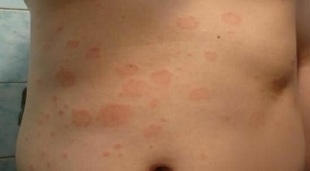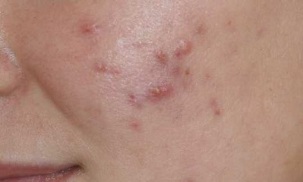
Photographs of psoriasis can help identify the disease in the early stages of development.
It is very important to understand that different people can manifest themselves in different ways - different in intensity, spreading activity, location of damage and other factors.
The first priority is to identify the symptoms and then start treatment immediately in the early stages of psoriasis.
Characteristics and symptoms of the initial stage
If you know exactly what the initial stage of psoriasis looks like, you can literally start treating the disease right away. There are characteristic signs of early-stage symptoms that allow for the treatment of early-stage psoriasis before a doctor’s visit.
Yes, not all people have the opportunity to see a dermatologist immediately in the early stages of the disease. Therefore, treatment at home by simple means is relevant. It can be a folk remedy and prescription, a non-hormonal ointment or a non-hormonal medicine.
What does psoriasis look like in its early stages? Pay attention to the condition of your skin.
The primary signs of early psoriasis are:
- Rash on different parts of the body with bright colors and clean edges. Areas of the skin that have recently suffered from burns, cuts, or hypothermia are particularly prone to such skin rashes. The primary signs may appear 7 to 14 days after skin damage;
- Exfoliation of the rash. They form in the middle of the boards;
- Itching. The plaques and papules of psoriasis gradually begin to itch. But not all psoriasis is itchy, so these symptoms are not universal. It occurs in about half of the patients.
Initially, the papules in the initial stage, i. e. pimples, are very small. They have a hemispherical shape and a smooth and shiny surface. After a few days, the size of the rash increases, with light scales forming on top.
If you scrape together this scale of the disease and find three characteristic phenomena, you can pinpoint exactly if you have psoriasis in the initial stages.
- Stearin stains. The scales should be removed very easily from the surface of the papules, even if you literally touch them a little.
- Movie. The heat foil appears after the flakes are removed. The skin underneath is red, thin and moist. The surface of the papula is glossy without scales.
- Dew. When you scrape the scales together and remove them, blood droplets will appear in place.
Initial symptoms usually last for several weeks. It is extremely important to start effective treatment during this period. If you ignore the disease, the papules can grow to 3 to 8 inches, merging into a single whole and touching huge areas of skin.
Initial manifestations of psoriasis
The initial stage of the course of the disease is accompanied by localization in different parts of the body. It is almost impossible to predict where psoriasis occurs. But it is possible to determine exactly how psoriasis appears in certain parts of the body in the early stages of the disease.

Most often, they suffer primarily from the first stage:
- Elbow;
- Legs;
- Head;
- Nails;
- Hand;
- Arc.
How does psoriasis appear on the body or other areas?
- Elbow.With ulnar psoriasis, the early stage photos make it clear that it is mainly a person who deals with the plaque form of the disease. The primary symptom is tiny red rash. The rash is covered with scales quite quickly. The skin is very rough.
- Legs.As with the elbows, there are small tiny rashes on the legs, the number of which gradually increases and increases. Often the very first papules are found in the area of the foot or knee. But in some cases, the lesions affect other surfaces of the legs.
- Head.There are two types of lesions - the skin or the hairy part. The ears and the back of the head suffer first. Papules on the head are often accompanied by unpleasant itching. The papules themselves are characterized by moisture and cracking.
- Nails.The photo allows you to clearly understand that nail psoriasis is similar in many ways to the manifestations of the fungus. First, longitudinal-type grooves form or a kind of depression appears at the edges of the nails. The disease then spreads to the roots of the nail. The nail plate will gradually become dull and noticeably thicken. As the disease progresses, the nails gradually peel off, detaching with the finger. There is little pleasant in this, so it is strongly recommended to see a doctor immediately. You will be prescribed the appropriate medication for external and internal use.
- Arc. Fortunately, for many people, especially women, facial psoriasis is a very rare form of the disease. But if you accidentally encounter it, you can determine it by the formation of red papules on the eyelids, lips and nose, near the eyes and eyebrows. In addition, psoriasis can appear on your face and form the appearance of delicate eyes. Tumors of psoriasis of the lips, tongue and oral mucosa are extremely rare.
- Hands.When psoriasis affects the hands, the flexible parts of them - the fingers and elbows - usually suffer for the first time. On the outside, it resembles psoriasis on the hands. There are situations where papules form on the surface of the palm. During this course of the disease, psoriasis usually also affects the legs.
Psoriasis Treatment Techniques

Once you have discovered the primary signs of the disease, see a doctor immediately and start getting rid of the disease. The problem for many is that they start treatment late. And the treatment of psoriasis requires a complex that has internal and external effects.
The essence of complex treatment is that several methods are used at the same time:
- Medication.The point is taking medication. They are all hormonal and non-hormonal. In the initial phase, only non-hormonal preparations are prescribed. You should only switch to hormonal medications, antibiotics, and other medications if the situation worsens and acute psoriasis develops.
- External effect.Here we are talking about the use of ointments, creams and shampoos. They use body lotions, balms, all kinds of decoctions and baths that are made according to folk recipes. Ointments are recognized as the most effective treatment for psoriasis. In this case, the ointments are both hormonal and non-hormonal. As with medications, use only non-hormonal ointments in the initial stages. They are quite effective, but do not have many contraindications and side effects.
- Physiotherapy.The patient may be prescribed ultraviolet radiation, PUVA therapy, electro-sleep, or other inpatient treatments. Physiotherapy is most effectively treated in sanatoriums and resorts.
- Proper nutrition.It is very important to make a lifestyle change if it is a factor in the onset of the disease due to the abuse of alcohol, fast food or cigarettes. Quite often, with the exclusion of harmful products and getting rid of addictions, a person’s condition normalizes and psoriasis does not bother for a very long time. This is a proven fact in practice.
A disease such as psoriasis can be detected and treated in the early stages. This is the most beneficial scenario for the patient as it takes minimal effort, time and money to suppress psoriasis.























